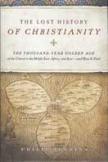Once-Thriving Centers of Faith
Some months ago, my wife and I stood in the square facing the dome and western facade of St. Mark’s Basilica in Venice. We marveled at the intriguing blend of Eastern and Western architecture before us.
We later visited the chapel in the crypt where the body of St. Mark had lain for several centuries after being abducted from Alexandria during the 17th century. We also gazed at the church’s high altar, beneath which the saint’s body now rests.
All this prompted me to think of the rich and varied historical influences of Christian faith on the church in Europe. I realized that much of this inheritance was from now largely deserted communities in Asia and Africa. Strong centers of Christianity had once existed to the east and south, but these had now but a flickering vestige of their former vitality.
For 1,000 years many “other” Christianities had once existed beyond Europe. We in the West have been inclined to dismiss them as peripheral at best, or at worst to reject them as churches embracing Monophysite or Nestorian heresies.
Now a splendidly revealing overview of these churches has appeared. Using his skill to discredit murky thinking and propose new understandings where the old no longer serve a good purpose, Philip Jenkins offers yet another jewel in what is becoming a crown of paradigm-shattering studies. The Lost History of Christianity: The Thousand-Year Golden Age of the Church in the Middle East, Africa and Asia—and How It Died will amply reward your investment of time and attention.
Christianity originated in the Near East, Jenkins reminds us. “It had its greatest centers, its most prestigious churches and monasteries in Syria, Palestine and Mesopotamia.” Were these Christians in fact the schismatics we have so casually assumed them to be? Hardly, says the author. “We must never think of these churches as fringe sects rather than as the Christian mainstream” of their time. Any history of Christianity that ignores these churches is missing a large part of the story. Forgetting them is as bad as losing them. To break the silence, we must recover the memories and restore the history.
The original Christian centers were in Asia, Africa and the Middle East. For many centuries, the churches located there possessed many of the characteristics of modern ecumenical communions. They were diverse, global in scope, rooted in the cultures where they existed and open to the influence of other great faith traditions.
In many ways they were “the original Christianities.” The “alternative Christianities” of Catholicism and Orthodoxy came later and filled a vacuum left by their demise.
While ancient churches like the Copts of Egypt and the Maronites of Lebanon have persisted to modern times, many did not. Why have some survived while others expired? Why have others vanished completely in one place only to re-emerge elsewhere?
Jenkins, professor of history and religious studies at Penn State, believes that the real question is not “why do churches die?” but “why do they endure?” Much of his book is an attempt to answer that question.
He describes in a series of chapters early Christianities stretching from North Africa to China; from Central Asia to Sri Lanka. One of the most interesting is the Mar Thoma church of Kerala State, India. Tracing its roots through the Syriac tradition and the apostle Thomas, this church has undergone various transformations in its 2,000-year history. Mar Thoma proudly refutes those who consider Christianity a late, foreign incursion.
Jenkins devotes considerable attention to the growth and development of Islam in regions formerly occupied by Christians. Early in its history, Islam was a rather tolerant religion that treated its non-Muslim minorities with respect. Only later, and at various crisis times, did Islam turn violent. The author tells that story candidly; Islamic persecutions were ruthless. He challenges Karen Armstrong’s thesis that Islam has always been a peace-loving faith. We learn, for example, of the Ottoman Turkish genocide of Armenian Christians and the gradual decimation of Christian Arabs in Palestine.
That said, Jenkins also reminds us of the equally bloody crusades and the persecutions of religious minorities in Christian Europe.
The latter chapters set a more positive tone as Jenkins poses penetrating questions concerning both the extinction and the resiliency of Christian communities. He paints sweeping portraits and grand cycles as well as singular moments of particular immediacy.
Important lessons can be learned from such a high-quality interpretation. Declines, notes Jenkins, were often the result of sectarian conflict, introversion, the lack of a missional vision, genuine groundedness in new cultures—even geographic location. Some communities were refined by the fires of persecution while others adapted themselves into irrelevance.
Human standards of what constitutes success may not match God’s criteria. Our definitions of success and failure are not ultimate or definitive, says Jenkins. To possess a mature understanding of the faith we need to recognize the meaning of disaster and defeat as well as triumph and growth. We need a theology of extinction, he holds, not just a missiology of continual Christian expansion.
My wife and I left the square of St. Mark in Venice and traveled in our imaginations to another famous sacred place—the Hagia Sophia in Constantinople. At one time this magnificent edifice was a Christian church. Now it is a major Islamic mosque. Will St. Mark’s in Venice remain a Christian basilica? Will the Hagia Sophia forever be a mosque?
There are no earthly guarantees, says Jenkins. Yet the chain of memory is itself a kind of resurrection.
This article also appeared in print, under the headline “Once-Thriving Centers of Faith,” in the January 5, 2009, issue.








